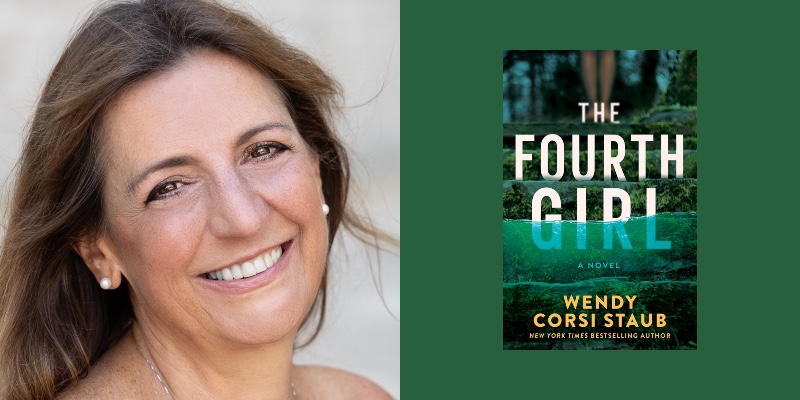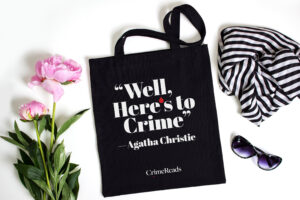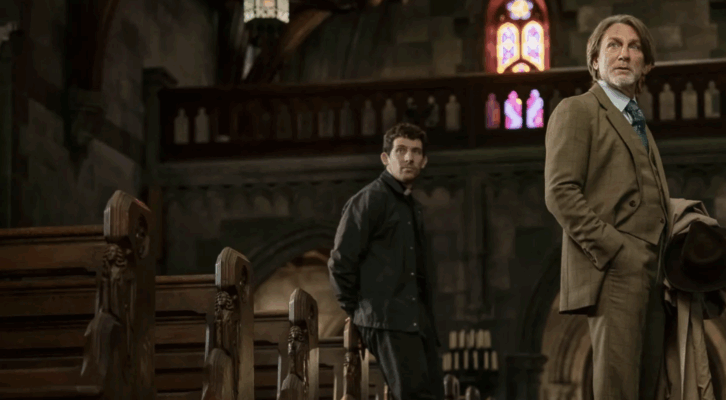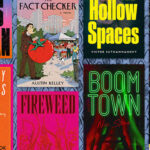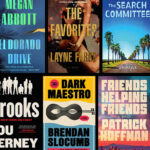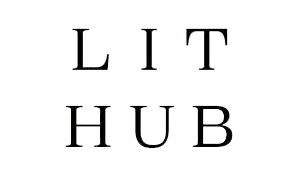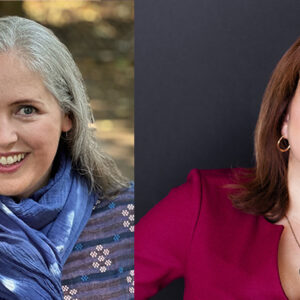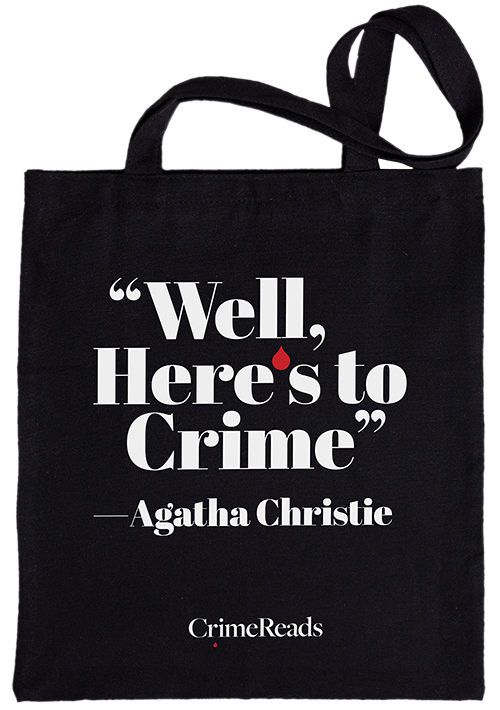So many stories to be told, so little time to tell them.
It’s a torment unique to writers—and one that has continued to motivate New York Times bestseller Wendy Corsi Staub for more than three decades in a prodigious career that has seen the publication of nearly 100 books across a variety of genres and under multiple names. But suspense has always been Staub’s sweet spot, from her early YA novels (Summer Lightening, Witch Hunt) to the series and standalone mysteries that have become her hallmark, earning accolades and awards, a loyal readership, and even comparisons to Mary Higgins Clark. Her latest, The Fourth Girl (Thomas & Mercer; April 1, 2025), is the first in a new series featuring a core group of friends haunted by the individual and shared traumas of their adolescence.
Twenty-five years ago, on prom night, Caroline Winterfield vanished from the grounds of Haven Cliff in upstate New York, never to be seen again. Only her three best friends, Midge, Kelly, and Talia, know what really happened under cover of darkness. Or at least they think they do. Flash forward to present day, and Midge—now a detective with the local police department—is called to the scene of a death, apparently accidental. But when she discovers a distinctive memento clutched in the victim’s hand, she realizes that the past has returned with a vengeance. As the three women reunite on the anniversary of Caroline’s disappearance, Midge can’t help suspecting that one of her friends may be a killer—or that all of them are targets.
In true Staub style, the story offers an abundance of riches, from its atmospheric setting (complete with an abandoned mansion in the woods) and authentic period details to a compelling cast of characters, all of whom have something to hide. Replete with clues, red herrings, and plot twists, the narrative alternates perspectives and timelines, effectively amplifying the suspense while fleshing out people and places—and the secrets they’ve both been keeping.
Now, Wendy Corsi Staub reflects on this bold new entry in a body of work that is defined by its endless chills and thrills …
John B. Valeri: The Fourth Girl marks the first book in a new series for a new publisher. What were the considerations of such an undertaking, both in terms of envisioning the story/saga itself and making it sellable to a different publishing house?
Wendy Corsi Staub: For me, there’s nothing more creative and gratifying than building a world and developing characters who become as familiar to me as the places and people I know in real life. I love to explore how events and relationships past and present can propel a plot. My editor at Thomas & Mercer was enthusiastic when I proposed a dual timelines tale, and that was all I needed to hear!
JBV: Twenty-five years ago, Caroline Winterfield vanished from the grounds of Haven Cliff, leaving her three best friends -– Midge, Kelly & Talia — to conceal the truth of her disappearance (as they know it). How does this event impact those left behind, both as a collective unit and individually – and why is it important that we meet these characters as both the children they were and the adults they’ve become?
WCS: Thematically, I have always loved to explore friendships—how they evolve over the decades, and how our formative years relationships help to influence and shape who we eventually become. On some level, all solid friendships involve confiding secrets and the presumption of loyalty—but especially for teenagers. What happens when those secrets involve life and death? What happens when a group of confidantes can’t agree on whether to keep a dangerous secret?
I wanted to delve into how much these women once meant to each other, how their differences and the pressure of their friend’s disappearance drove them apart, how they’ve found their way back to each other….and what happens next?
JBV: To expand on that: the narrative structure alternates viewpoints and timeframes. What was your process like to account for the characters and circumstances in play – and how did the editorial process (and plotting collaboration with your son Brody) help to shape these arcs as the story evolved?
WCS: There’s a whole lot of story here! I find that sometimes when I’m launching a new setting and characters, I don’t yet know enough about the world I’m building, but sometimes, I know too much. This was the latter. The idea had been percolating for a while, and there’s so much room to play! There’s a lot I intend to do with these multigenerational characters and past and present mysteries, going forward.
For book one, I had to restrict the narrative, past and present, to hone the plot to pertinent moments. How to define them? It was incredibly helpful to sit down for hours one day with my son Brody, who took notes and tracked threads as I outlined my ideas. In the end, tens of thousands of words ended up on the cutting room floor or saved for future Haven Cliff installments. The book went through five full drafts with welcome expert guidance from my developmental editor at Thomas and Mercer, who knows the crime genre inside and out.
JBV: You evoke a powerful sense of place, from Haven Cliff itself to each friend’s individual home and the town of Mulberry Bay at large. In what ways does setting enhance story – and how does the aforementioned juxtaposition of past and present allow for an exploration of change over time (or, sometimes, the lack thereof)?
WCS: I’ve always felt that a worthwhile setting functions as character; that my characters should inhabit a three-dimensional and realistic community. If I’m doing my job, then the events that propel my characters, and their actions and reactions to these events, simply could not unfold the same way in any other setting.
I love exploring how Mulberry Bay and Haven Cliff (the abandoned gilded age estate) have evolved over the decades; how boom years and hard times have impacted the people who live there, those who left, and newcomers. After all, so much of small-town America, particularly in upstate New York, has seen fluctuation over the last century when it comes to population, local economy, the housing market, etc. Those issues impact the people and events in ways large and small, and—importantly—they drive conflict.
JBV: Let’s talk about the art of telling details. In the book’s past segments (which encompass the 90s and early 2000s), you reference everything from fashion to pop culture to world events. What is the import of such deets – and how do you endeavor to present them in a way that comes across as organic rather than forced?
WCS: Memory is such a powerful device—in real life, and in fiction. How often do you hear an old song, or catch a whiff of, say, a certain brand of sunscreen—that throws you right back to a time and place in your own life? Or remember exactly where you were when some historic event unfolded? Memory and the past itself play an important role here. Sometimes I use broad strokes to evoke time and place in a flashback scene—a reference to Seinfeld, or some trendy fashion. Sometimes, the seemingly small details I’m using are far more intentional and relevant, and will later become an Aha! moment for the reader—like when the teenagers react to the news of Princess Diana’s death in 1997. A couple of pop culture details presented in The Fourth Girl will become relevant (As clues? Red herrings?) in the sequel I’m writing now. Careful readers, take note!
JBV: The Fourth Girl has both a decisive ending and some unresolved questions. How do you endeavor to balance closure with continuation so that readers are left satisfied but with some degree of suspense? Also, tell us about how the approach to Book One differs from those that come after.
WCS: It’s so difficult to know where/how to wrap up. The original ending to The Fourth Girl included a final scene that I absolutely loved, because it was a massive twist for the reader and opened the door to the sequel. It took everything you thought you knew about what has unfolded and undid it with a blindside. I wound up cutting it, because rather than providing a sense of closure, it was a cliffhanger that would not be resolved until the next book’s publication. Not including this scene in the first book doesn’t erase it from my mind as I’m writing the sequel. It did take place. It is important. I’ve simply opted not to show the reader….yet.
JBV: You have authored nearly 100 books in 30+ years – an impressive feat of quantity and quality. How does such proliferation both ease the path and make it more challenging? Also, what continues to energize and motivate you as a storyteller despite the perils of the business?
WCS: Having written and published crime fiction consistently over a long career, I’ve become proficient in certain aspects of craft that might present challenges to a newcomer. Elements like scene structure or dialogue can feel second nature when you’ve worked with them for so many years. On the other hand, I often have to check myself and ask….is this a crime, or a character, or a twist I’ve used before? It gets blurry after all these years, and I always want to keep things fresh, particularly for my loyal longtime readers. My motivation, pure and simple, is that storytelling isn’t just what I do; it’s who I am. As a true storyteller, you’re bombarded with more ideas than you’ll ever be able to write in one lifetime. But I aim to try!
JBV: Leave us with a teaser: What comes next?
WCS: The Lost Summer (Coming in spring, 2026), the sequel to The Fourth Girl, picks up a few months after we left off. There’s a new crime for Midge Kennedy to investigate, and she and Talia and Kelly are still working on their reconciled relationship as well as coming to terms with what they’ve uncovered about Caroline’s disappearance. And Toil and Trouble, the seventh title in my Lily Dale Mysteries series, will be out in July!

